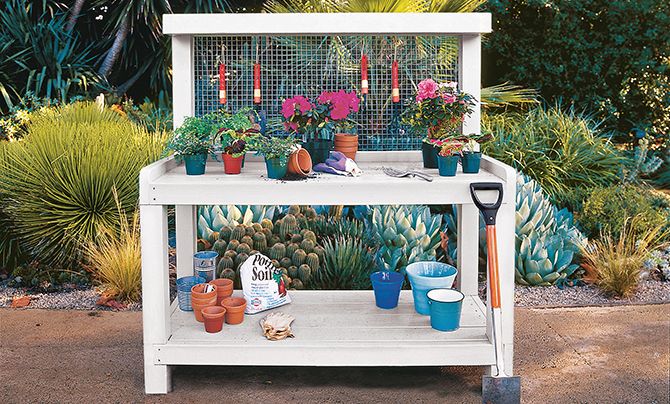We may be compensated if you purchase through links on our website. Our team is committed to delivering honest, objective, and independent reviews on home products and services.
Project details
Skill
Cost
Estimated Time
A potting bench is essential for any avid gardener, providing a dedicated workspace for planting, repotting, and organizing gardening supplies. You can easily make one yourself in under a day. Our guide walks through how to build a simple, three-tier potting bench with a wire mesh backing to keep your favorite hand tools at your fingertips.
Planning Your Potting Bench Project
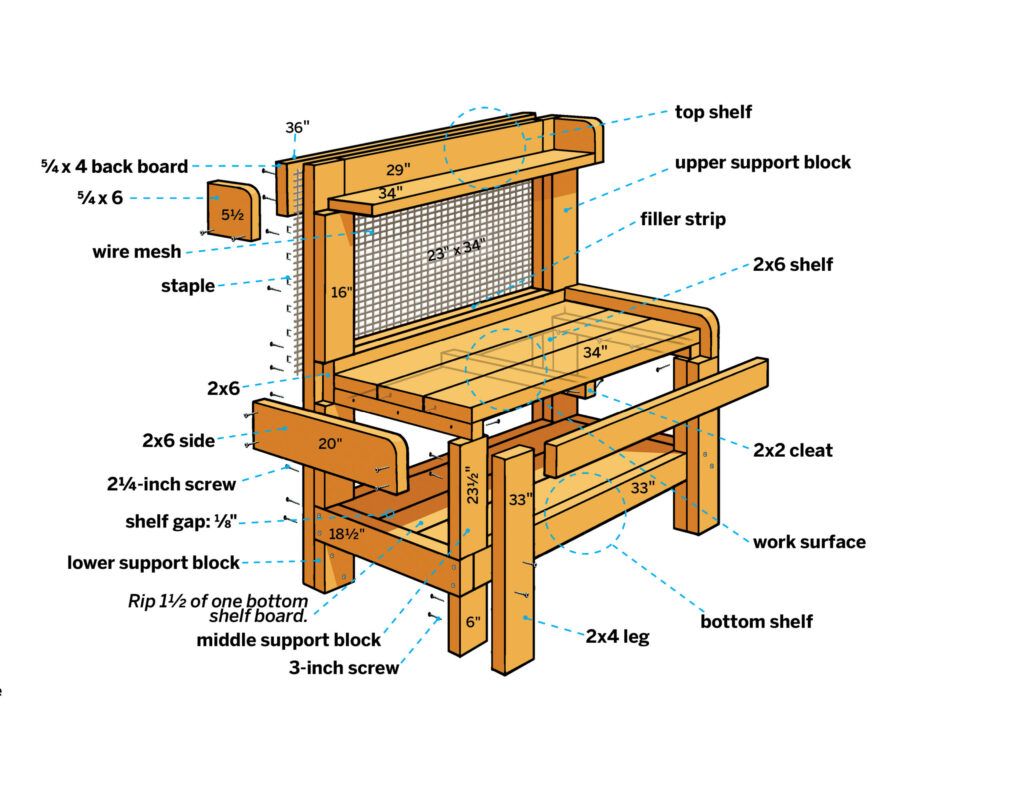
This section will guide you through selecting the right materials and determining the right size potting bench for your needs.
Choosing the Right Materials
Think about whether you’re going to leave your bench outside. If you are, we recommend cedar and pressure-treated lumber because they’re resistant to rot and insects. Cedar is more expensive but offers natural beauty and durability. Pressure-treated lumber is more budget-friendly but requires a weather-resistant finish to last.
Determining the Ideal Size and Height
Tailor the size and height of your potting bench to your needs and available space. A standard potting bench is typically around four feet wide and two feet deep, but you can adjust these dimensions to suit you. Aim for a work surface that’s at a comfortable height—usually between 36 and 38 inches tall. This helps you work efficiently without straining your back or shoulders.
Exploring Design Possibilities
Consider various design elements such as a backsplash to prevent soil spillage, decorative trims, or wheels. Explore different shapes and styles that match your garden’s look, making sure the final design is both functional and visually appealing. Look for inspiration in magazines, online platforms, or even garden centers.
Essential Tools and Materials for Building a Potting Bench
Here’s what you’ll need to build your potting bench.
Tools
- Circular saw or table saw
- Drill and drill bits
- Level
- Measuring tape
- Pencil
- Safety glasses and work gloves
- Screwdriver
Materials
For a basic potting bench, gather these materials:
- 2×2 lumber for support cleats
- 2×4 lumber for the frame and legs
- 5/4×6 or 2×6 boards for the work surface and shelves
- Exterior wood screws
- Weather-resistant wood finish or paint
- Wire mesh for the backing
Download a printable potting bench cut list.
 Jigsaw
Jigsaw Miter saw
Miter saw Drill/driver
Drill/driver Staple gun
Staple gun
Step-by-Step Construction Process
Now that your materials and tools are ready, let’s dive into construction. Follow these steps to build your potting bench.
Step 1: Building the Work Surface
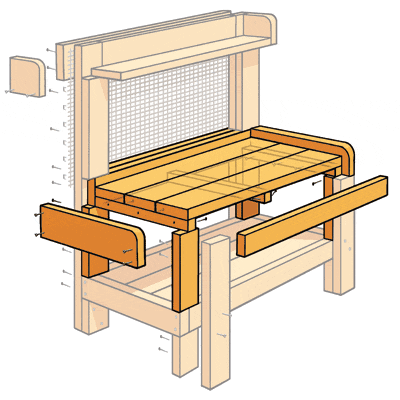
The work surface will serve as the main area for your gardening tasks. Cut the work surface frame’s side pieces to size, using a jigsaw to create curved profiles if desired. Assemble the frame by screwing the pieces together with the bottom edges flush. Attach cleats along the sides and middle of the frame (all flush with the bottom edges), then secure the shelf boards to these cleats.
Step 2: Making the Bottom Shelf
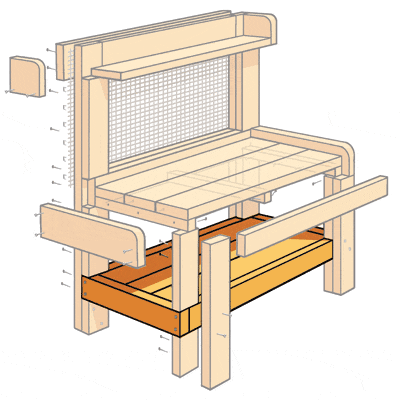
This bottom shelf can hold pots, tools, or soil. Screw the shelf’s frame together. Secure cleats to the sides and across the middle of the frame, flush with the bottom edges, as in Step 1. Attach the shelf boards to the cleats.
Step 3: Attaching the Legs
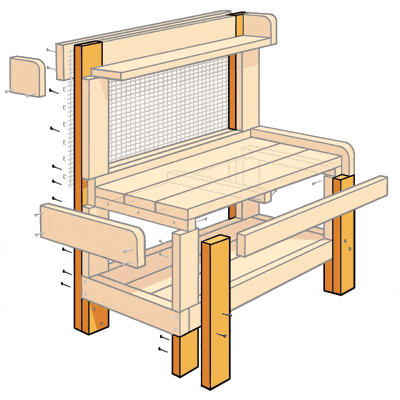
Make sure your shelves are square and level when you attach them to the legs. Screw the lower support blocks to the legs, then prop up the bottom shelf on the blocks and secure it to the legs as well. Screw the middle support blocks to the legs and rest the work surface on the blocks. Screw the work surface and then the upper support blocks to the legs.
Step 4: Inserting the Top Shelf
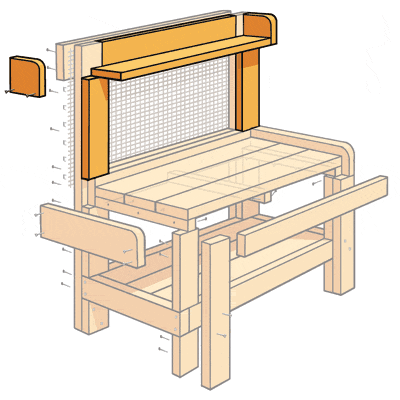
Cut curved profiles on the shelf’s sides if desired, then screw them to the shelf. Size the back of the shelf so that it fits snugly between the legs and secure it. Rest the shelf on the upper support blocks.
Step 5: Attaching the Wire Mesh
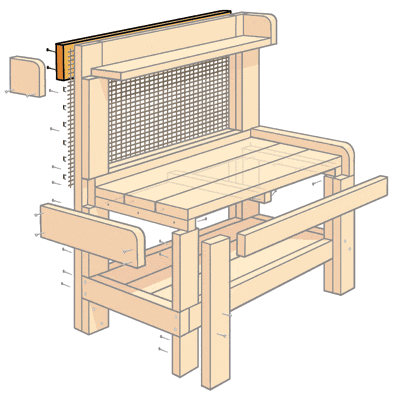
Secure a filler strip to the back side of the work-surface frame, between the legs. Staple wire mesh to the back of the bench. Finally, secure a board over the mesh to hold the top shelf in place. Keep in mind that you may have to remove the top shelf to replace the mesh in the future.
Customizing Your Potting Bench
Consider these customizations to make your bench more useful and stylish.
Adding a Sink
A sink allows for easy plant watering and tool cleaning without having to leave your workspace. When adding a sink, make sure you incorporate proper drainage. Use a salvaged or repurposed sink to decrease costs and add character to your bench.
Incorporating Storage
Add storage to maximize the efficiency of your potting bench. Install hooks or pegs for hanging tools, add drawers for small items such as seeds and gloves, or incorporate shelving for pots and larger supplies. These additions help keep your workspace organized and all your gardening essentials within easy reach.
Enhancing Aesthetic Appeal
Enhance the look of your potting bench by painting or staining it to complement your garden’s style. Use vibrant colors to make it a focal point or natural wood finishes for a rustic look. Add decorative elements such as garden-themed motifs, stencils, or personalized nameplates. These touches make your potting bench not just functional but also a beautiful addition to your outdoor space.
Must-Have Accessories
Equip your potting bench with accessories that complement your gardening routine:
- Built-in thermometer
- Grow light setup for starting seedlings
- Labeled containers for seeds
- Pegboard for hanging frequently used tools
- Small compost bucket for plant trimmings
- Soil bin for easy access to potting mix
- Water pump
- Weather-resistant outlets (we recommend hiring an electrician for this one)
Maintaining Your Potting Bench
Proper maintenance will ensure your potting bench remains functional and attractive for years. Follow these tips to keep your bench in top condition.
Cleaning and Care Tips
Regularly clean your potting bench to prevent the buildup of dirt and plant debris. Use a stiff brush to remove loose soil, and wipe down surfaces with a mild soap solution. Allow the bench to dry completely to prevent moisture damage. Periodically check and tighten any loose screws or fittings to maintain structural integrity.
Weatherproofing Techniques
Apply a weather-resistant finish or paint to protect your potting bench from the elements. A clear sealer can help maintain cedar’s natural beauty while providing protection. Pressure-treated lumber should be sealed or painted to enhance its weather resistance. Reapply finishes annually or as needed.
Seasonal Care and Inspection
Inspect your bench at the beginning of each season. Look for signs of wear, such as splintering or cracking, and repair any damage promptly, and check metal components for rust. Regular checks help you fix small issues before they turn into major problems.
